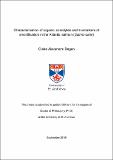Files in this item
Characterisation of organic osmolytes and biomarkers of smoltification in the Atlantic salmon (Salmo salar)
Item metadata
| dc.contributor.advisor | Hazon, N. (Neil) | |
| dc.contributor.advisor | Cramb, Gordon | |
| dc.contributor.author | Dagen, Claire Alexandra | |
| dc.coverage.spatial | 375 p. | en_US |
| dc.date.accessioned | 2021-02-23T15:49:03Z | |
| dc.date.available | 2021-02-23T15:49:03Z | |
| dc.date.issued | 2020-12-01 | |
| dc.identifier.uri | https://hdl.handle.net/10023/21491 | |
| dc.description.abstract | Atlantic salmon are an economically important species, particularly in Scotland. The aquaculture of this species is complicated by its anadromous life cycle, requiring transfer to seawater. Smoltification is a complex process whereby fish prepare for entry to seawater, the “smolt window” is the time at which fish are best adapted for the transition to seawater. In the aquaculture setting fish are unable to self-select and may be transferred to the marine environment outwith their optimal smolt window, it is thus important that the mechanisms involved in seawater adaptation are well understood. The accumulation of organic osmolytes forms an important part of the adaptation to seawater, allowing fish to maintain osmotic and ionic balance within their tissues. A novel osmolyte identified in a pilot study was characterised and the metabolism of this compound investigated. The novel compound was identified as hypoxanthine, a purine involved in the nucleotide salvage pathway. This osmolyte and taurine were found be accumulated in the skin of Atlantic salmon in the days and weeks following seawater transfer. A number of potential biomarkers of smoltification were also investigated with an aim to develop a more robust set of markers of the hypo-osmoregulatory ability of fish. Genes involved in the transport of ions were found to be the most reliable indicators of smoltification. | en_US |
| dc.language.iso | en | en_US |
| dc.publisher | University of St Andrews | |
| dc.rights | Creative Commons Attribution-NonCommercial-NoDerivatives 4.0 International | * |
| dc.rights.uri | http://creativecommons.org/licenses/by-nc-nd/4.0/ | * |
| dc.subject | Atlantic salmon | en_US |
| dc.subject | Salmon | en_US |
| dc.subject | Osmoregulation | en_US |
| dc.subject | Organic osmolyte | en_US |
| dc.subject | Osmolyte | en_US |
| dc.subject | Hypoxanthine | en_US |
| dc.subject | Biomarker | en_US |
| dc.subject | Smolt | en_US |
| dc.subject | Smoltification | en_US |
| dc.subject | Aquaculture | en_US |
| dc.subject | Anadromous | en_US |
| dc.subject | Euryhaline | en_US |
| dc.subject | Feeding trial | en_US |
| dc.subject.lcc | QL638.S2D2 | |
| dc.subject.lcsh | Atlantic salmon | en |
| dc.subject.lcsh | Smolting | en |
| dc.subject.lcsh | Biochemical markers | en |
| dc.subject.lcsh | Osmoregulation | en |
| dc.title | Characterisation of organic osmolytes and biomarkers of smoltification in the Atlantic salmon (Salmo salar) | en_US |
| dc.type | Thesis | en_US |
| dc.contributor.sponsor | EWOS Innovation (Firm) | en_US |
| dc.contributor.sponsor | Marine Harvest (Firm) | en_US |
| dc.contributor.sponsor | University of St Andrews. School of Biology | en_US |
| dc.type.qualificationlevel | Doctoral | en_US |
| dc.type.qualificationname | PhD Doctor of Philosophy | en_US |
| dc.publisher.institution | The University of St Andrews | en_US |
| dc.publisher.department | School of Biology | en_US |
| dc.identifier.doi | https://doi.org/10.17630/sta/31 |
The following licence files are associated with this item:
This item appears in the following Collection(s)
Except where otherwise noted within the work, this item's licence for re-use is described as Creative Commons Attribution-NonCommercial-NoDerivatives 4.0 International
Items in the St Andrews Research Repository are protected by copyright, with all rights reserved, unless otherwise indicated.


